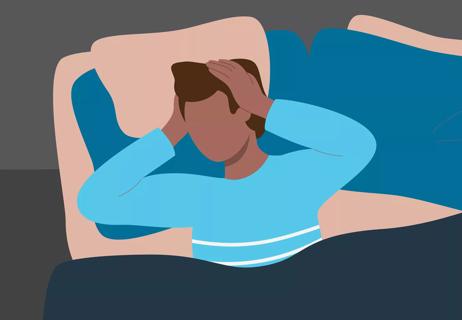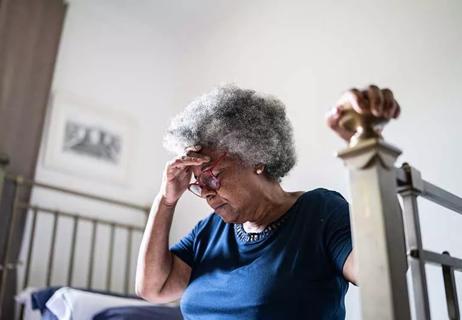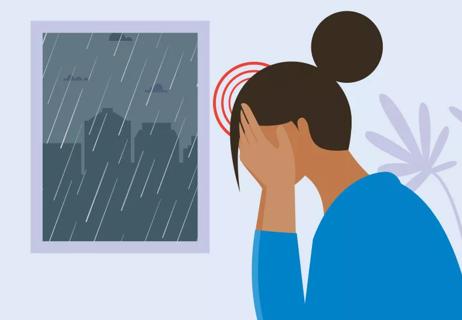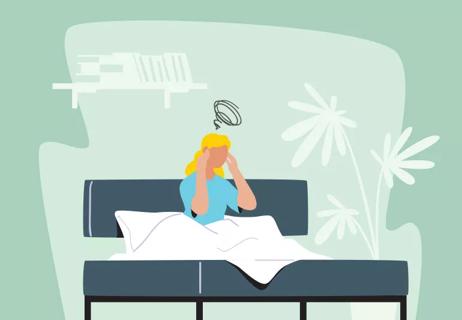Our expert explains the ins and outs of these illnesses

Dealing with headaches is never fun. Even the lighter ones are a nuisance, disrupting the flow of your day until they fade or some over-the-counter medicine helps resolve the pain.
Advertisement
Cleveland Clinic is a non-profit academic medical center. Advertising on our site helps support our mission. We do not endorse non-Cleveland Clinic products or services. Policy
But for some, the headaches are every day, the pain can range from mild to severe, and, sometimes, they never go away. These are called chronic daily headaches. And while they can come in different forms, they have one thing in common: they negatively affect the daily lives of those who suffer from them.
To better understand the types of chronic daily headaches, what causes them and how to treat them, we spoke with neurologist Payal Soni, MD.
According to Dr. Soni, a chronic daily headache is any headache that occurs 15 or more days out of the month and is present for three months or longer. She adds, “A chronic daily headache is a primary headache disorder which means it’s not caused by another condition.”
People of any age are susceptible to chronic daily headaches, she says.
Some risk factors include:
If you develop regular headaches and you suspect this could be the onset of a chronic daily headache, Dr. Soni says to reach out to your primary healthcare provider.
She also recommends keeping track of your headaches. “It can be helpful to track your headaches or keep a journal so you have a good idea of how often they occur.”
Advertisement
This information can also be useful when you see your healthcare provider because it can be difficult to remember every headache you have over several days or weeks. And the notes you take about your headaches – where it occurs, other associated symptoms – can also help determine what type of chronic daily headache you’re dealing with.
There are five types of chronic daily headaches, according to Dr. Soni. They are:
Chronic migraines are similar to episodic migraines, Dr. Soni says. “We know migraines are a genetic disorder that involves the dysregulation of neurotransmitters, inflammation and excitable electrical activity in the brain.”
While migraines are generally an episodic disorder – meaning you’ll have a migraine headache followed by periods where you have no pain – it’s possible for them to transition to chronic migraines. “There are epidemiological studies that claim that episodic migraines become chronic for about 2.5% of migraine patients each year,” Dr. Soni notes. “It’s just kind of the natural course of the disease.”
Another potential cause for the transition, she says, are lifestyle factors. For instance, the overuse of either prescription or over-the-counter (OTC) headache medications can lead to what’s known as a medication overuse headache. As your body adapts to the constant use of these medications to manage the pain, the headaches become more frequent and more severe, developing into an almost daily occurrence.
Dr. Soni also says that some research indicates there might be a genetic predisposition for developing chronic migraines, but that cause isn’t as well understood yet.
Like chronic migraines, chronic tension-type headaches often begin as episodic headaches but transition to chronic headaches, says Dr. Soni. What separates this type of headache from migraines are the symptoms.
Tension-type headaches are typically mild to moderate in terms of pain and don’t interfere with a person’s daily life the same way the severe pain associated with migraines can. Additionally, tension-type headaches feel more like squeezing or pressing than throbbing and affect both sides of the head or the whole head.
Some migraine symptoms like sensitivity to light and noise as well as nausea and vomiting are not present with these tension-type headaches.
A chronic post-traumatic headache is a recurring headache that develops after some sort of head trauma. “It doesn’t even have to be a severe trauma, either,” Dr. Soni says. But if you already have a history of migraine or tension-type headaches, she says, that can put you more at risk of developing the chronic headache pattern after a trauma like a concussion.
“Traditionally, post-traumatic headaches are present after the injury but resolve within a few weeks to a few months,” says Dr. Soni. “But some patients develop the prolonged course where it becomes a more chronic pattern.”
Advertisement
This type of headache, Dr. Soni says, is a continuous headache that begins without any real warning. “It’s a new headache that’s daily and persistent from the onset, with no pain-free period.”
It can affect both sides of the head, she adds, and share symptoms with both migraine and tension-type headaches. But unlike those chronic types of headaches, these generally come out of the blue with no previous headache history.
While the other types of chronic daily headaches are more typical, hemicrania continua is a fairly rare headache disorder, according to Dr. Soni. “One of the characteristics of this particular type of headache is that it involves only one side of the head,” she notes. “And the pain is continuous and daily from the onset.”
Hemicrania continua is also different from the other types of headaches in that it’s associated with autonomic symptoms. “These can include tearing or redness of the eye on the same side as the pain as well as unequal pupils or a drooping eyelid on the same side as the pain,” Dr. Soni says. “It can also include nasal congestion or a runny nose on the same side as the pain.”
As for what causes these rare headaches, Dr. Soni says the exact cause isn’t known. “We always want to rule it out as a symptom of something else, like a structural lesion on the brain or a tumor, but as a primary headache disorder, we don’t know the exact cause.”
Advertisement
When we think about headache treatment, we tend to think about a reactive approach: You develop a headache, you take the over-the-counter medication of your choice (aspirin, Tylenol, etc.) and you go on about your day.
With these chronic-type headaches, though, Dr. Soni says it’s all about getting ahead of the headaches in the first place with preventive treatment.
“Preventive treatment is typically medication you take every day, regardless of whether or not you have a headache that day,” she says. “The goal is reducing the overall number of headaches you have.”
If you’re taking OTC medications more than two days a week to manage headache pain, she adds, you need to talk to your healthcare provider about switching to this prevention medicine.
For these two kinds of chronic headaches, Dr. Soni says that some of the more effective migraine treatments include medications typically used for seizures, blood pressure and depression. There’s also been some overlap in using those to treat tension-type headaches, but she adds, “Tension-type headaches may respond a little bit better to some of the seizure or antidepressant medications as well was muscle relaxers.”
Based on symptoms, treatment for post-traumatic and new daily headaches generally follows the treatment as migraines or tension-type headaches, she says.
Advertisement
For hemicrania continua, Dr. Soni says that patients typically respond to an anti-inflammatory medicine called indomethacin.
“Response to indomethacin is actually part of the diagnostic process for hemicrania continua,” she adds. “We’ll often do a trial, which is both diagnostic and therapeutic for the patient.”
Treating these headaches goes beyond medication, though. “Other aspects of treatment are extremely important and often overlooked,” Dr. Soni points out. “Even with the medications, you’re not going to get instant relief and it can take some trial and error to figure out the regimen that’s best for you.”
It’s important, she says, that the patient’s lifestyle not be disregarded while that trial and error takes place. “Medications are just one piece of the treatment,” she says.
Dr. Soni says one way patients can start to ease pain is by adapting to what’s called a “migraine lifestyle.”
“It isn’t very different from a normal, healthy lifestyle, but it focuses on headache triggers and other aspects that can worsen your pain.”
Getting a good idea of what triggers your headaches, especially migraines, is important because not everyone has the same triggers. “They may not always be consistent, but identifying the most common ones – things like alcohol, your diet or certain stress – can help you avoid them.”
Changes in your routine can also be triggers.
“Your brain likes to stick to a routine, especially as we get older,” Dr. Soni explains. “Sticking to a routine, no matter if it’s a weekday or weekend, can really help as can good sleep hygiene. Making sure you’re getting enough restful, refreshing sleep is key.”
Diet is also important. Avoiding processed or packaged foods to improve your diet can be a positive step as well as staying hydrated by drinking plenty of water.
Exercise is also a key component, but Dr. Soni acknowledges that can be difficult if you’re suffering from chronic headaches.
“Many patients with these headaches may feel that they don’t have the energy for exercise or that exercise may worsen their headaches,” she says. “Often, it’s not the exercise that’s triggering the headaches but the condition that plays a role.”
Low-impact exercises can be one way to still stay active despite these headaches. “Things like yoga, Tai Chi, even simple stretching at home can be beneficial,” she adds.
“Starting with shorter exercises can also be helpful in getting your body that needed workout without tiring you out. Then, as you feel comfortable, you can work your way up to more activity.”
Dr. Soni points out that managing stress and anxiety as well as your approach to a situation is important in treating these chronic headache conditions. “It’s understandable that when you’re in pain, especially chronic pain, that you’ll feel angry or defeated or lost,” she says. “But a negative attitude can make the recovery process even harder.”
Instead, taking a positive outlook, taking things one step at a time and celebrating even the small victories are important. “Each person has something different that fills their cup. Finding what works for you and helps you focus on your healing is really important,” she adds.
If you or a loved one find yourself dealing with these types of headaches, it’s extremely important that you contact your healthcare provider for diagnosis and treatment. There’s no reason to continue suffering and rely on OTC medicines which, as Dr. Soni noted, become less effective over time.
The pain in a patient’s life can also be a big impediment.
“When you look at someone suffering from chronic headaches, they typically don’t show outward signs of an illness or disability,” she says. “It’s an invisible illness.” And, she adds, chronic headaches – particularly chronic migraines – are under-diagnosed and under-treated as many patients never seek care.
A patient with one of these chronic conditions isn’t able to perform at 100% at all times, and that can affect all aspects of their life — from work to family to relationships with friends. It can also directly affect other areas of their health, as Dr. Soni mentions, from sleep to exercise.
Treating these chronic conditions, especially ones with so many unknowns, can be frustrating for patients and healthcare providers alike. “There may be patients with whom we try every treatment we can and they’re still living with this chronic pain.”
Ultimately, many patients benefit from an interdisciplinary treatment that includes medication, mental health, a pain psychologist, physical therapy and even occupational therapy. “The focus,” Dr. Soni says, “is on function and improving the quality of life.”
An improvement of 50% in terms of pain is often a marker for success, she adds. “Having a goal or expecting pain levels to fall to zero, for those headaches to go away, that’s a terrific achievement if we can get there. But it’s not always realistic. We have to keep those expectations realistic to get the most out of treatment.”
Learn more about our editorial process.
Advertisement

Dehydration, spinal fluid leaks and other conditions can cause positional headaches when you stand up

It’s all about the amount — try to stick to 100 to 150 milligrams a day to reduce and prevent a pounding, throbbing head

Many factors, like dehydration, a cold or even your medication, can result in these common symptoms

Behind your eye, on one side of your face or as a band around your head — headaches are no fun

Yes, especially if you get migraines — but medicine can help

If it isn’t a hangover or teeth grinding, your aching head might be a sign of a sleep disorder

The effect is very real for some people

Understanding when it may (and may not) be the culprit

If you’re feeling short of breath, sleep can be tough — propping yourself up or sleeping on your side may help

If you fear the unknown or find yourself needing reassurance often, you may identify with this attachment style

If you’re looking to boost your gut health, it’s better to get fiber from whole foods